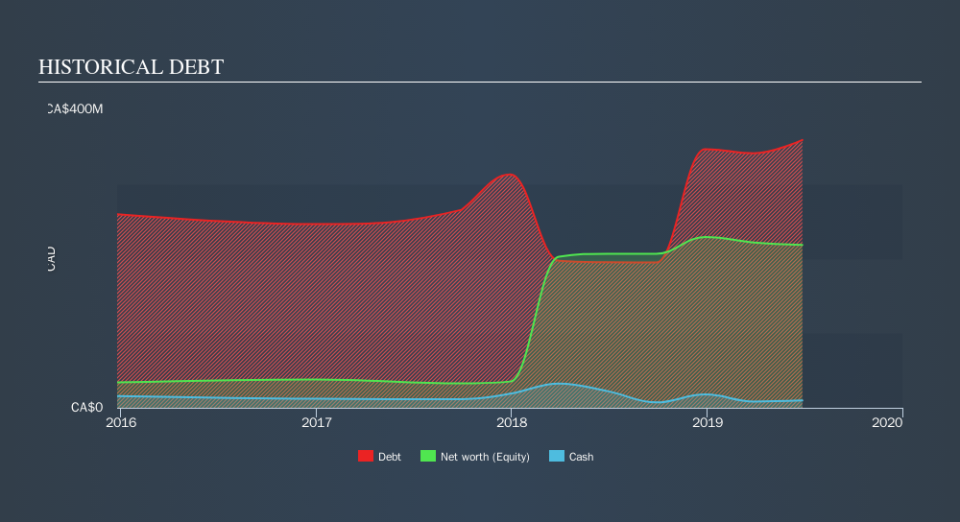Pinnacle Renewable Energy (TSE:PL) Seems To Be Using An Awful Lot Of Debt

The external fund manager backed by Berkshire Hathaway's Charlie Munger, Li Lu, makes no bones about it when he says 'The biggest investment risk is not the volatility of prices, but whether you will suffer a permanent loss of capital.' When we think about how risky a company is, we always like to look at its use of debt, since debt overload can lead to ruin. We note that Pinnacle Renewable Energy Inc. (TSE:PL) does have debt on its balance sheet. But the real question is whether this debt is making the company risky.
When Is Debt A Problem?
Debt is a tool to help businesses grow, but if a business is incapable of paying off its lenders, then it exists at their mercy. Part and parcel of capitalism is the process of 'creative destruction' where failed businesses are mercilessly liquidated by their bankers. However, a more frequent (but still costly) occurrence is where a company must issue shares at bargain-basement prices, permanently diluting shareholders, just to shore up its balance sheet. Of course, debt can be an important tool in businesses, particularly capital heavy businesses. The first step when considering a company's debt levels is to consider its cash and debt together.
Check out our latest analysis for Pinnacle Renewable Energy
How Much Debt Does Pinnacle Renewable Energy Carry?
The image below, which you can click on for greater detail, shows that at June 2019 Pinnacle Renewable Energy had debt of CA$359.1m, up from CA$195.1m in one year. However, it does have CA$9.83m in cash offsetting this, leading to net debt of about CA$349.2m.
How Strong Is Pinnacle Renewable Energy's Balance Sheet?
The latest balance sheet data shows that Pinnacle Renewable Energy had liabilities of CA$135.1m due within a year, and liabilities of CA$309.2m falling due after that. On the other hand, it had cash of CA$9.83m and CA$135.7m worth of receivables due within a year. So its liabilities outweigh the sum of its cash and (near-term) receivables by CA$298.7m.
This deficit is considerable relative to its market capitalization of CA$344.1m, so it does suggest shareholders should keep an eye on Pinnacle Renewable Energy's use of debt. Should its lenders demand that it shore up the balance sheet, shareholders would likely face severe dilution.
In order to size up a company's debt relative to its earnings, we calculate its net debt divided by its earnings before interest, tax, depreciation, and amortization (EBITDA) and its earnings before interest and tax (EBIT) divided by its interest expense (its interest cover). The advantage of this approach is that we take into account both the absolute quantum of debt (with net debt to EBITDA) and the actual interest expenses associated with that debt (with its interest cover ratio).
Weak interest cover of 1.2 times and a disturbingly high net debt to EBITDA ratio of 7.4 hit our confidence in Pinnacle Renewable Energy like a one-two punch to the gut. This means we'd consider it to have a heavy debt load. Even worse, Pinnacle Renewable Energy saw its EBIT tank 25% over the last 12 months. If earnings keep going like that over the long term, it has a snowball's chance in hell of paying off that debt. When analysing debt levels, the balance sheet is the obvious place to start. But ultimately the future profitability of the business will decide if Pinnacle Renewable Energy can strengthen its balance sheet over time. So if you want to see what the professionals think, you might find this free report on analyst profit forecasts to be interesting.
Finally, a business needs free cash flow to pay off debt; accounting profits just don't cut it. So we clearly need to look at whether that EBIT is leading to corresponding free cash flow. Over the last three years, Pinnacle Renewable Energy saw substantial negative free cash flow, in total. While that may be a result of expenditure for growth, it does make the debt far more risky.
Our View
To be frank both Pinnacle Renewable Energy's conversion of EBIT to free cash flow and its track record of (not) growing its EBIT make us rather uncomfortable with its debt levels. And furthermore, its net debt to EBITDA also fails to instill confidence. Taking into account all the aforementioned factors, it looks like Pinnacle Renewable Energy has too much debt. That sort of riskiness is ok for some, but it certainly doesn't float our boat. Given our concerns about Pinnacle Renewable Energy's debt levels, it seems only prudent to check if insiders have been ditching the stock.
Of course, if you're the type of investor who prefers buying stocks without the burden of debt, then don't hesitate to discover our exclusive list of net cash growth stocks, today.
We aim to bring you long-term focused research analysis driven by fundamental data. Note that our analysis may not factor in the latest price-sensitive company announcements or qualitative material.
If you spot an error that warrants correction, please contact the editor at editorial-team@simplywallst.com. This article by Simply Wall St is general in nature. It does not constitute a recommendation to buy or sell any stock, and does not take account of your objectives, or your financial situation. Simply Wall St has no position in the stocks mentioned. Thank you for reading.


